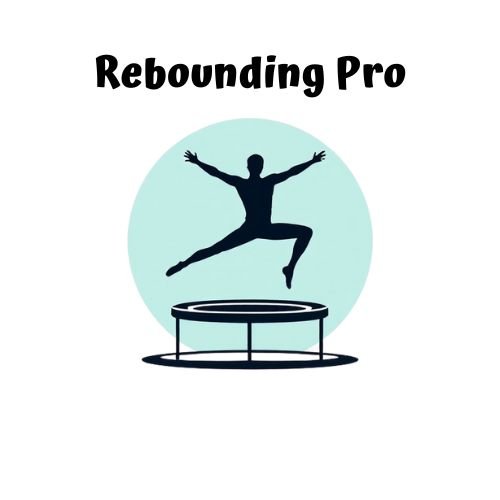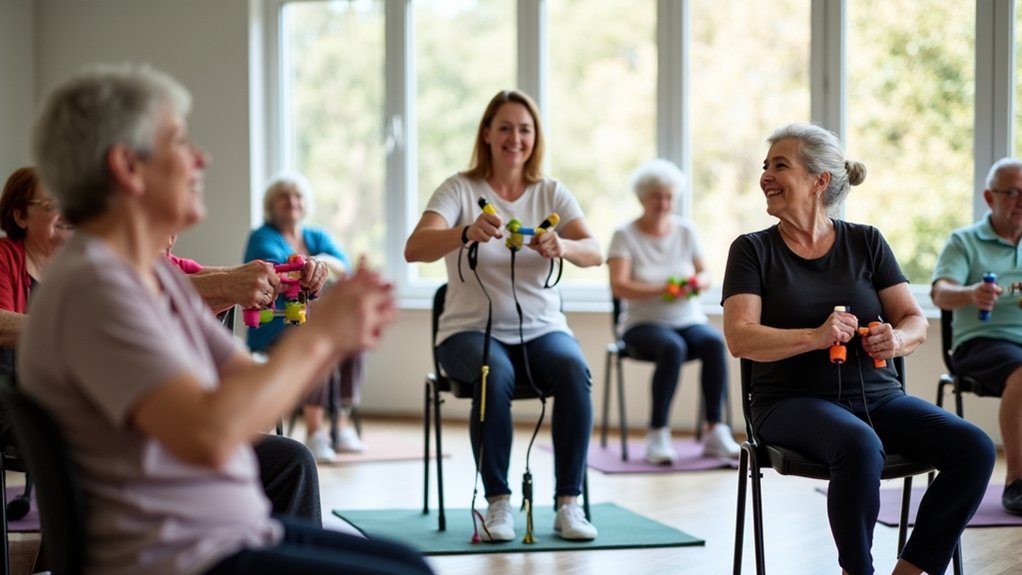Low-impact exercises like rebounding on mini-trampolines markedly boost joint health by stimulating synovial fluid circulation. This natural lubricant nourishes cartilage while the gentle bouncing motion activates your lymphatic system, flushing out inflammatory compounds. Unlike high-impact activities, rebounding absorbs up to 80% of stress while still strengthening muscles around joints. You’ll experience improved mobility, reduced stiffness, and enhanced joint function with just 10-15 minutes of gentle bouncing several times weekly. Discover how this gentle motion transforms joint health.
The Science Behind Joint Fluid Circulation and Exercise

While many people understand that exercise is important for overall health, the specific benefits to joint function often remain overlooked. When you move your joints, you’re creating shear forces that stimulate synovial fluid production – your body’s natural joint lubricant.
This fluid, derived from blood plasma, doesn’t just reduce friction; it’s essential for nourishing cartilage that lacks direct blood supply. During physical activity, type B synoviocytes activate to produce lubricin and hyaluronic acid, enhancing the fluid’s viscosity and protective properties. The synovial fluid acts as oil in an engine, improving joint mobility and function.
Exercise also promotes waste removal from joint tissues while triggering gene expression involved in cartilage repair. The increased circulation delivers oxygen and nutrients to these structures that would otherwise receive limited nourishment.
Physical activity initiates metabolic waste clearance while activating genes that regenerate joint cartilage through enhanced nutrient delivery.
Even moderate movement can greatly improve this circulation process, reducing your risk of developing conditions like osteoarthritis.
How Rebounding Exercise Promotes Synovial Fluid Movement
Rebounding exercise offers a uniquely effective approach to joint health through its distinctive bouncing motion. When you bounce on a mini-trampoline, you’re creating gentle gravitational shifts that stimulate synovial fluid circulation without harsh impact on your joints. This low-impact activity helps lubricate joint surfaces while strengthening surrounding muscles. The Health Bounce technique emphasizes pressing down rather than jumping up for maximum joint protection.
| Rebounding Benefit | Joint Health Impact | Implementation Tip |
|---|---|---|
| Gentle G-force changes | Stimulates synovial fluid movement | Start with 2-minute sessions |
| Low-impact motion | Reduces joint strain | Keep feet close to mat initially |
| Muscle engagement | Supports joint stability | Add resistance bands for enhancement |
Unlike high-impact exercises, rebounding allows you to gain cardiovascular benefits while protecting vulnerable joints. The lymphatic system also benefits, enhancing immune function and detoxification. You’ll find rebounding particularly beneficial if you’re managing arthritis or recovering from joint injury.
Mini-Trampoline Workouts That Protect Joint Health

You’ll protect your joints while exercising on a mini-trampoline since it absorbs up to 80% of impact stress compared to high-impact activities like running.
Your lymphatic system gets activated during rebounding workouts, which helps remove waste products from joint tissues and reduces inflammation.
Start with gentle bouncing for short periods, then gradually increase your workout intensity as your balance improves and muscles strengthen around your joints.
Mini-trampoline workouts are considered low-impact exercise while still delivering effective fitness results for your entire body.
Bounce Without Joint Strain
When traditional exercises like running send shockwaves through your body, mini-trampoline workouts offer a gentler alternative that protects your joints.
These rebounding exercises absorb approximately 80% of the impact compared to pavement running, dramatically reducing strain on your knees, hips, and ankles.
You’ll still get a vigorous cardiovascular workout—similar to running—but with less perceived exertion.
The bouncing motion promotes synovial fluid circulation, naturally lubricating your joints while strengthening the surrounding muscles that provide essential support.
For those with arthritis or joint sensitivity, mini-trampolines (available in 32-48 inch surfaces) provide an accessible way to stay active without aggravating symptoms. Consider models with bungee cords for a smoother and safer bouncing experience that further protects sensitive joints.
Regular sessions of just 10-30 minutes several times weekly can improve joint mobility and reduce stiffness while burning up to 700 calories per session.
Lymphatic System Activation Benefits
The gentle up-and-down motion of mini-trampoline workouts creates a remarkable effect on your lymphatic system, producing benefits that go far beyond joint protection.
Unlike blood circulation, your lymphatic system lacks a pump, relying instead on the compression and decompression that rebounding naturally provides.
As you bounce, you’re flushing toxins, dead cells, and inflammatory compounds from your joints and surrounding tissues. This cleansing process reduces joint swelling and inflammation commonly associated with arthritis.
You’ll also experience improved delivery of nutrients to joint tissues while metabolic waste is efficiently removed.
The rhythmic bouncing simultaneously strengthens muscles surrounding your joints, enhances bone density, and improves cardiovascular function—all working together to create an ideal environment for joint health through improved lymphatic circulation. Rebounding is especially beneficial as a low-impact cardio option since the trampoline mat absorbs over 80% of the impact.
Gradual Intensity Progression
Starting mini-trampoline workouts with a gradual approach protects your joints while building strength and confidence over time.
These rebounding exercises reduce joint stress by approximately 80% compared to walking on pavement, making them ideal for joint health maintenance.
Begin with gentle bounces that keep your feet close to the surface, then progress to higher intensity movements like high knees or jumping jacks as your comfort increases.
For added stability, consider using a mini-trampoline with T-bar handles, especially when you’re new to rebounding.
You’ll notice improved balance and coordination as you continue, which further reduces fall risk.
The full-body engagement strengthens core and leg muscles that support your joints, creating a positive cycle of improved mobility and reduced pain without excessive impact.
The bellicon’s unique suspension system allows for gentle, controlled movements that minimize shock to your joints while still providing an effective workout.
Comparing Rebounding to Other Low-Impact Exercises for Joints

Among the variety of low-impact exercises available, each offers distinct benefits for joint health and overall mobility. While rebounding on trampolines isn’t typically highlighted for joint health, options like swimming provide superior joint protection through water’s buoyancy while delivering full-body conditioning.
Low-impact exercises deliver joint-friendly benefits, with swimming outperforming trampoline workouts through water’s protective buoyancy and complete muscular engagement.
You’ll find cycling excellent for leg strength with minimal knee and hip stress, while walking offers accessibility and effective joint maintenance. Walking on softer surfaces can further reduce the impact on your joints while still providing cardiovascular benefits.
Elliptical trainers simulate running without the harsh impact, making them ideal alternatives for cardiovascular fitness.
For extensive joint care, consider incorporating water aerobics, resistance band training, or mind-body practices like yoga, tai chi, and Pilates.
These activities strengthen the muscles surrounding your joints while improving flexibility and alignment—all vital elements for long-term joint health without compromising your cardiovascular fitness.
Starting a Safe Rebounding Routine for Arthritic Joints
If you’re managing arthritis but still want to stay active, rebounding offers a promising low-impact option that can accommodate sensitive joints while providing valuable exercise benefits.
Before beginning, consult your healthcare provider to ascertain rebounding is suitable for your specific condition.
Start with a quality mini-trampoline featuring adequate joint support and consider models with stability bars if balance is a concern.
Begin with just 2-3 minutes of gentle bouncing, keeping your feet on the mat to minimize knee strain. The gentle motion helps increase synovial fluid circulation in your joints, improving lubrication and nourishment. Always warm up with light stretches before each session.
As you progress, gradually increase your time to 10-15 minutes, 2-3 times weekly.
Remember to maintain slightly bent knees throughout and stop immediately if you experience pain beyond normal discomfort.
The Long-Term Benefits of Rebounding for Joint Mobility
While many exercise options exist for those with joint problems, rebounding stands out as a particularly effective long-term strategy for improving joint mobility and function. The consistent, low-impact nature of rebounding stimulates bone formation while strengthening the stabilizing muscles around your joints, creating a foundation for better movement as you age. Rebounding reduces 87% of impact shock compared to exercising on hard surfaces like concrete or asphalt.
- Your joint range of motion and proprioception improve considerably, leading to smoother, more controlled movements in daily activities.
- Deep core muscles strengthen involuntarily, enhancing joint stability without conscious effort.
- Enhanced circulation delivers nutrients to joint tissues while the lymphatic system removes inflammatory waste products.
These benefits compound over time, potentially reversing joint stiffness while preventing further deterioration—all without the damaging impact common to other exercise forms.
Enhancing Your Rebounding Workout With Complementary Exercises
Rebounding workouts become even more effective when you incorporate complementary exercises that enhance their joint-friendly benefits.
Try adding basic bounces and jogging in place to warm up muscles before progressing to high knees or speed skater jumps that boost cardiovascular output while targeting multiple muscle groups.
Begin with gentle bounces and jogging to prepare your body for more dynamic movements that elevate your heart rate and engage your entire muscular system.
For strength development, perform squats on the unstable surface to activate stabilizing muscles and improve joint stability. Rebounding exercises are particularly beneficial for older adults as they help improve bone mineral density and reduce fracture risk.
Single-leg hops challenge your balance while strengthening glutes and quads.
Don’t overlook your core—incorporate twist jumps and opposite hand-to-knee taps to support spinal stability.
To maximize lymphatic benefits, include jumping jacks and weight shift movements that stimulate fluid circulation.
Always maintain proper posture with your core engaged and shoulders back, and consider using a stability bar if you’re a beginner.
Frequently Asked Questions
Can Rebounding Exercises Worsen Existing Joint Inflammation?
Rebounding exercises typically don’t worsen joint inflammation due to their low-impact nature. You’ll actually benefit from improved lymphatic drainage and enhanced circulation, but should start gradually and consult your doctor if you have concerns.
How Does Weather Affect Joint Health During Rebounding Workouts?
Weather considerably impacts your rebounding workouts. Cold temperatures cause joint stiffness, while barometric pressure changes can trigger discomfort. You’ll need proper warm-up, layered clothing, and hydration to protect your joints during outdoor sessions.
Are Ankle Weights Safe to Use During Rebounding Exercises?
No, ankle weights aren’t generally safe for rebounding. They strain your joints, alter movement patterns, and increase injury risk. If you’re determined to use them, stay under 3 pounds and master proper form first.
How Often Should Rebounding Equipment Be Replaced for Safety?
You should replace your rebounding equipment every 2-5 years depending on usage. Check nets, mats, and springs before each use and replace immediately if you find tears, holes larger than 1 inch, or weakened attachments.
Can Rebounding Improve Bone Density Alongside Joint Health?
Yes, you’ll improve bone density while protecting joints through rebounding. The gravitational stimulus strengthens bones without joint stress, and NASA research shows it’s particularly effective at the femoral neck—a critical fracture risk area.
In Summary
You’ve now learned how rebounding on a mini-trampoline can transform your joint health through improved synovial fluid circulation. By incorporating this low-impact exercise into your routine, you’ll protect your joints while enhancing mobility. Start slowly, listen to your body, and you’ll likely experience reduced pain and increased flexibility. Remember, consistency is key—even short rebounding sessions will contribute to healthier, more resilient joints long-term.





Leave a Reply